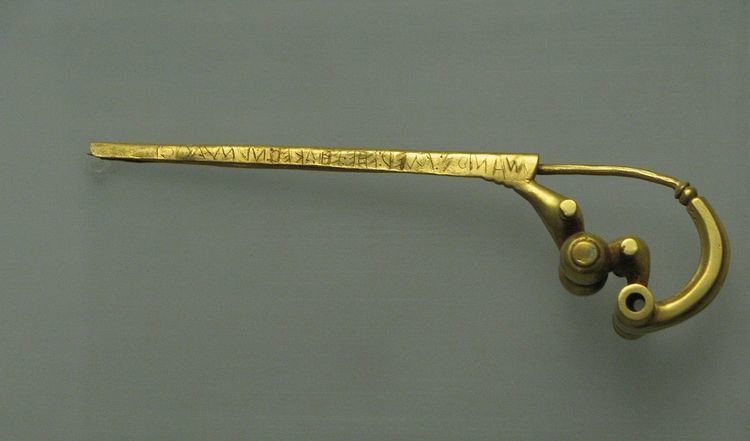 | ||
The Praeneste fibula (the "brooch of Palestrina") is a golden fibula or brooch, today housed in the Museo Preistorico Etnografico Luigi Pigorini in Rome. The fibula bears an inscription in Old Latin. At the time of its discovery in the late nineteenth century, it was accepted as the earliest known specimen of the Latin language. The authenticity of the inscription has since been disputed. A new analysis performed in 2011 declared it to be genuine "beyond any reasonable doubt" and to date from the Orientalizing period, in the first half of the seventh century BC.
Contents
Discovery
The fibula was presented to the public in 1887 by Wolfgang Helbig, an archaeologist. At the time, Helbig did not explain how he had come to acquire the artifact.
Date and inscription
The fibula was thought to originate from the 7th century BC. It is inscribed with a text that appears to be written in Old Latin, here transcribed to Roman letters:
MANIOS MED FHEFHAKED NVMASIOIThe equivalent Classical Latin sentence obtained by applying the appropriate differences between Old Latin and Classical Latin would probably have been:
*MANIVS ME FECIT NVMERIOtranslated as:
Manius made me for NumeriusHoax theory
In 1980 Margherita Guarducci, a leading epigraphist, published a book claiming that the inscription had been forged by Francesco Martinetti, an art dealer, and Helbig, who were known to have collaborated in shady dealings. Its presentation in 1887, she claimed, was in fact a hoax perpetrated to advance the careers of both men. This was the most formal but not the first accusation of its kind: Georg Karo had said that Martinetti told him he had stolen the fibula unengraved from the Tomba Bernadini.
Claimed authenticity
Evidence in favor of the genuineness of the text came from a new Etruscan inscription of the Orientalizing period published by Massimo Poetto and Giulio Facchetti in 1999. The inscription scratched on the body of an Etrusco-Corinthian aryballos shows a gentilicium, Numasiana, which provides confirmation of the genuineness of the name Numasioi on the Fibula Prenestina, often regarded as suspicious by the supporters of the theory that it was a forgery.
In 2011, new scientific evidence was presented by the research team of Edilberto Formigli and Daniela Ferro, whose optical, physical and chemical analyses allowed them to take into consideration smaller scrapes on the surface of the object than was possible in the 1980s. Observation by means of Scanning Electron Microscope (SEM) and detailed physical and chemical analyses on the surface of small areas within the track of the incision showed the existence of micro-crystallization of the gold surface: a natural phenomenon that could have taken place only in the course of centuries after the fusion. The study reported that a 19th-century forger could not have realized such a forgery.
